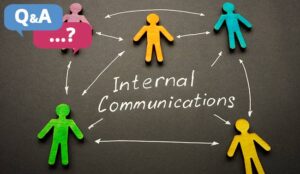Is the way you communicate with your staff more likely to make them drift off to sleep than perk up with excitement at the prospect of changes in the business? If so, let Gemma Gibson give you a few hints and tips.
Call centres are major hubs of communication. We talk with each other, we talk with customers, we listen in to calls, we measure the communication between our agents and our customers, and we also deliver communication skills training programmes. But when it comes to internal communication, sometimes the message may get lost or have the opposite effect to that we expected.
By understanding the possible barriers to communication we can work to create effective, inspirational and innovative communications with our people. We can potentially save our call centres tens of thousands of hours and hundreds of thousands of pounds by successfully communicating to people. Conversely, if we get it wrong, it could have a negative impact on morale, performance, attrition, people issues and ultimately dent our overall culture as people may believe they are being treated unfairly.
Communication is one of the major organisational factors that has the greatest impact on people’s morale. It is essential during any period of change – whether that be introducing new internal call guidelines, new shift patterns or incentive programmes, future legislative policies, or large-scale transitions such as restructures, downsizing or outsourcing.
Imagine you are sending out a piece of communication, perhaps verbally supported by a written document. When you deliver the message it is well received, the questions that are subsequently asked are positive and forward thinking, the feedback and comments you receive are complimentary. Everybody has bought in and is keen to be involved in this new project or change. People are talking about it afterwards and you overhear them saying great things about the news they’ve received and the difference they will see in the future. How useful would it be to learn some of the secrets to achieving this in all future communications?
Communicating at this level – and with these results – is not an impossible dream. But exactly where should you start?
Why definition is key
First and foremost, if your call centre has regular communication updates – be they bulletins, newsletters, briefs or memos – it is useful to define some guidelines for them all. This could be the format or template for the communication, or it may be the values and principles that all communication will stand by from here on in. Honesty, succinctness, straightforwardness and a future-focused approach are just some of the principles and values you may want to embrace.
When people receive any communication they instantly begin to think. They have questions in their minds about what they’ve just heard or read and they make statements to themselves about the impact it will have on them as individuals, about how others either directly or indirectly related will see the move, and about the situation itself. People also recall memories from the same or similar experiences from the past, and they imagine what the future might be like both immediately and in the long-term.
I call these facets the ‘four thinking components’. Whatever the content of your message is, I can guarantee that your audience will be thinking in these ways. It may be helpful to them – that is, they might be telling themselves: “This sounds like a great plan”, “I’d love to get involved in this”, “I wonder how I could do something to help?” or “This will be brilliant when it’s in place”. Alternatively, their thinking could be hindering them. “This has happened before and it didn’t work then”, “They are always coming up with these hare-brained ideas” and “How on earth are we going to achieve that? It’s madness” are some of the things they might be telling themselves.
Bear these contrasts in mind when it comes to defining your guidelines for communication. Be aware that each individual will have their own thoughts and that they may well have either entirely helpful, entirely hindering or a mixture of both types of thoughts going through their minds. Also, know who your target audience are and try to second-guess what their reactions might be. I often imagine myself being the other person, hearing what I am saying to them. I ask myself: “What might be going through their mind when I say this?”
Ask yourself this question while you think about a number of different people to allow yourself to consider the many possibilities. By acknowledging these thoughts and possible reactions before they arise, you have a stronger chance of gaining people’s buy-in when you communicate with them. You can adapt your communication to answer their questions, and assist them in making helpful statements to themselves and remembering great things. You can also help them to learn from any not so positive memories and to imagine what great things will happen once the action has taken place.
Getting others to help get the message across
Of course, you may not be in a position to communicate with everybody on your own and will likely need to involve others to help you. This is the second key rule, therefore: negotiate with your ‘communication team’ and agree who is going to deliver the communication. Will it come directly from the senior team or are the line managers going to cascade information down? Things to consider are:
- The importance of the communication to the overall business targets. If it is a high priority, you might want to ensure that it is delivered by one person who is a role model within the senior team.
- How the message might be diluted through the channels or key information might get lost in translation. Make sure others are aware of the key goals of the communication and arrange for a pre-briefing or practice session beforehand.
- The possibility that managers will not take responsibility but will deliver an ‘It’s them, not me’ style briefing. Encourage them to consider the ’four thinking components’ of their audience. Ask them: “What might the team be saying to themselves about you as a manager if you aren’t confidently delivering a message?”
After that, decide the appropriate communication method for maximum impact. Be innovative and inspirational; look at all media, including visual and audio. Might a movie-style poster, newspaper column, song, advert, plasma screen image, briefing or report have the effect and contain the message you want to deliver? Involve others and remember that anything is a possibility. See how many different ways you can come up with to communicate with your call centre teams. From all the possible ways you generate you can pick out the ones you want to use for regular injections of news and updates and the ones that will deliver the right, powerful message at the time it is most needed.
Be clear about what you want to communicate, too. Give an explanation within the communication as well as the message itself. We know people will have questions and thoughts in their minds; if you don’t give the organisational reasons behind the key message, they will come up with their own. This may of course be hindering and add to their feelings of uncertainty or insecurity.
Think carefully about the language you use in your communication, as well. Management buzzwords may turn people off, so use straightforward language. Asking questions – especially high quality questions – will make people think. You may want to indirectly involve others by using quotes from them to make a point or to demonstrate the success of something similar to what you are proposing. We know that people will be thinking to themselves, so to keep their focus on some future actions. It’s best to say what you want rather than what you don’t want.
What comes next?
After you have delivered your communication, encourage questions, thoughts and comments from your audience. Allow them the opportunity to raise queries in a relaxed atmosphere – whether that be immediately, as a group or one to one. Identify whether their questions or comments are helpful to them or hindering them and spend time with each individual to understand their reactions. If you can communicate with them and understand their thoughts and reactions, you will be able to help them see their role and areas of responsibility and identify what opportunities are available for them.
Finally, before you begin communicating, identify how you will monitor and measure it so you know when you have been successful. Really think about what ‘successful communication’ looks like. And remember to celebrate your success however you like.
If you invest the time thinking about and preparing your communication, you will reap the rewards. So, next time you’re thinking about communicating, ask yourself:
- What do I wish to communicate?
- What are the reasons behind this communication?
- How could I possibly communicate this message in the easiest / quickest / most inspiring way?
- Who could I possibly involve in helping me communicate this message?
- What things might I need to help me communicate this in an innovative way?
- What assumptions might I possibly be making about my audience?
- What possible thoughts (questions / statements / memories / imagined future) might the recipients have?
- How could I make sure all those thoughts are helpful and positive through my communication?
- What do I want the recipients to be imagining when they hear / read this?
- How much time do I need to put aside for delivering this communication effectively?
- How will I know that the communication is successful?

Gemma Gibson is a thinking engineer with Go MAD Research and Consulting Group
Tel: +44 1509 891 313
Website: www.gomadthinking.comIf you are issuing some communication in the future and would like a free assessment of it, Gemma will be happy to help. Simply e-mail it to her on gemma@gomadthinking.com and she will give it a free check-up and offer you some feedback.In addition, if you would like to download any free e-books about how to get what you want, when you want – packed with tips about how successful thinking can really make a difference – please go to www.gomadthinking.com website and, when you enter your details, put callcentrehelper.com in the box to note where you heard about the company.
Author: Jonty Pearce
Published On: 31st Aug 2006 - Last modified: 17th Sep 2019
Read more about - Call Centre Management, Communication



































